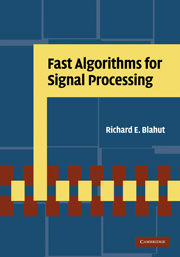Book contents
- Frontmatter
- Contents
- Preface
- Acknowledgments
- 1 Introduction
- 2 Introduction to abstract algebra
- 3 Fast algorithms for the discrete Fourier transform
- 4 Fast algorithms based on doubling strategies
- 5 Fast algorithms for short convolutions
- 6 Architecture of filters and transforms
- 7 Fast algorithms for solving Toeplitz systems
- 8 Fast algorithms for trellis search
- 9 Numbers and fields
- 10 Computation in finite fields and rings
- 11 Fast algorithms and multidimensional convolutions
- 12 Fast algorithms and multidimensional transforms
- A A collection of cyclic convolution algorithms
- B A collection of Winograd small FFT algorithms
- Bibliography
- Index
11 - Fast algorithms and multidimensional convolutions
Published online by Cambridge University Press: 03 May 2011
- Frontmatter
- Contents
- Preface
- Acknowledgments
- 1 Introduction
- 2 Introduction to abstract algebra
- 3 Fast algorithms for the discrete Fourier transform
- 4 Fast algorithms based on doubling strategies
- 5 Fast algorithms for short convolutions
- 6 Architecture of filters and transforms
- 7 Fast algorithms for solving Toeplitz systems
- 8 Fast algorithms for trellis search
- 9 Numbers and fields
- 10 Computation in finite fields and rings
- 11 Fast algorithms and multidimensional convolutions
- 12 Fast algorithms and multidimensional transforms
- A A collection of cyclic convolution algorithms
- B A collection of Winograd small FFT algorithms
- Bibliography
- Index
Summary
Just as one can define a one-dimensional convolution, so one can define a multidimensional convolution. Multidimensional linear convolutions and cyclic convolutions can be defined in any field of interest on multidimensional arrays of data and are useful in many ways. We have seen in earlier chapters that multidimensional arrays and multidimensional convolutions can be created artificially as part of an algorithm for processing a one-dimensional data vector. Multidimensional arrays also arise naturally in many signal-processing problems, especially in the processing of image data such as satellite reconnaissance photographs, medical imagery including X-ray images, seismic records, and electron micrographs.
This chapter will begin the study of fast algorithms for multidimensional convolutions by nesting fast algorithms for one-dimensional convolutions. Then we shall study ways to construct a fast algorithm for a one-dimensional cyclic convolution by temporarily mapping it into a multidimensional convolution, a procedure that is known as the Agarwal–Cooley convolution algorithm. The Agarwal–Cooley algorithm for one-dimensional cyclic convolution is a powerful adjunct to the convolution methods studied in Chapter 6, which become unwieldy for large blocklength. It gives a way to build algorithms for large one-dimensional cyclic convolutions by combining the small convolution algorithms. Then, in the latter half of the chapter, we shall study methods that are derived specifically to compute two-dimensional convolutions.
Nested convolution algorithms
A two-dimensional convolution is an operation on a pair of two-dimensional arrays.
- Type
- Chapter
- Information
- Fast Algorithms for Signal Processing , pp. 345 - 383Publisher: Cambridge University PressPrint publication year: 2010
- 1
- Cited by



